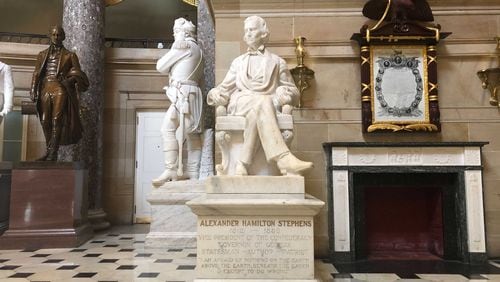As U.S. Rep. Marjorie Taylor Greene, R-Rome, continued to tangle with House Speaker Mike Johnson and her fellow Republicans this week, an interesting change was taking place inside the U.S. Capitol, part of a series of new faces coming to Capitol Hill.
And elected officials in Georgia should probably pay close attention.
This change has to do with statues. Under a federal law signed by President Lincoln in 1864, each state gets to send two statues for display at the U.S. Capitol.
The sculptures are supposed to honor important people. Southern states often used it in the 1920′s and 1930′s to send statues of Confederate leaders and military heroes.
It was meant to send a message.
The Southern statues notably include Confederate President Jefferson Davis (1931, Mississippi) and Confederate Vice President Alexander Hamilton Stephens (1927, Georgia).
Slowly but surely now, the Confederate and white supremacist statues are getting sent back.
Two years ago, Florida replaced a Confederate general with a statue of Mary McLeod Bethune, a Black educator.
Next week, North Carolina will unveil a statue of the Rev. Billy Graham, which will replace one of Charles Aycock, who as governor pressed to take away the vote from Black people.
“Let the Negro learn once for all that there is unending separation of the races,” Aycock said in 1903.
This summer, Arkansas will send a statue of famed singer Johnny Cash to replace one of former U.S. Sen. James P. Clarke, a strong supporter of segregation who wanted to preserve ‘white standards of civilization.’
This week, Arkansas swapped out the state’s other statue, sending one of NAACP leader Daisy Bates, who helped mentor the nine Black students who integrated Central High School in Little Rock in 1957.
Bates now stands next to Jefferson Davis — that’s right, a Black woman, next to the President of the Confederacy. How about that for a historic juxtaposition?
Mississippi can do better than Davis, just as Georgia can do better than Alexander Hamilton Stephens, who declared that ‘the Negro is not equal to the white man.’
While that message may have played well in Georgia’s past, it most certainly does not represent Georgia’s present or future.
2027 will mark 100 years since the Stephens statue arrived in D.C. There must be someone of historical note from Georgia who could send a better message to the thousands of tourists who walk through the U.S. Capitol each year.
Who could gain bipartisan support? Three years ago, there was talk at the Gold Dome about rallying around baseball great Hank Aaron, instead of a push for the late Congressman John Lewis. But it didn’t go anywhere.
No matter the choice, it’s time for someone new, Georgia. It’s the 21st century.
Jamie Dupree has covered national politics and Congress from Washington, D.C. since the Reagan administration. His column appears weekly in The Atlanta Journal-Constitution. For more, check out his Capitol Hill newsletter at http://jamiedupree.substack.com







